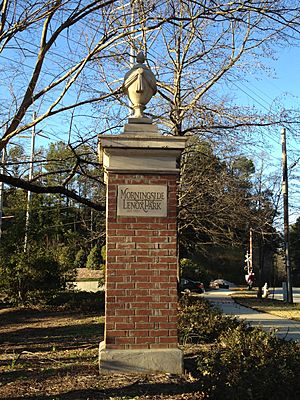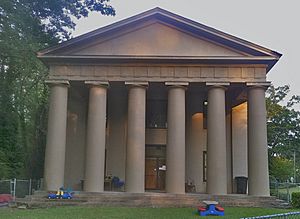Morningside/Lenox Park facts for kids
Morningside/Lenox Park is a cool neighborhood in Atlanta, Georgia. It was started in 1923. You can find it north of Virginia-Highland, east of Ansley Park, and west of Druid Hills. About 3,500 families live here. The neighborhood includes several original areas like Morningside, Lenox Park, University Park, Noble Park, Johnson Estates, and Hylan Park.
Contents
History of Morningside/Lenox Park
Early Days and Native Americans
Long ago, the land where Atlanta is now was home to the Creek Indians. In 1832, after a law called the Indian Removal Act, the Creek leaders signed a treaty. This meant they gave up their lands east of the Mississippi River to the U.S. and moved to a new territory.
Many of Atlanta's first settlers came from Northeast Georgia, the Carolinas, and Virginia. Some of them settled in a farming community called Easton. This was near where Piedmont Avenue and Monroe Drive are today. Farmers who lived near creeks built mills powered by water. These mills helped them saw wood and grind corn. Easton farmers used Walker's Mill, which was across from what is now Ansley Mall.
Rock Spring Church and the Train
In the winter of 1868, a religious man named Joel Mable started the Union Sunday School. It was in the Rock Spring School House, near where Morningside Drive and East Rock Springs Road meet now. Two years later, 27 people started the Rock Spring Presbyterian Church. Many of their family names, like Cheshire and Plaster, are still known today. The first church building was a simple white building without a steeple. It was built in 1871 where the church stands today, at Piedmont Avenue and Rock Springs Road.
In 1876, people in Easton started using a steam train called the Airline Belle. It ran between Atlanta and Toccoa for 42 years. Commuters would get on the train at a station near today's Ansley Mall. By 1888, Easton had 100 residents. By 1900, many people from Easton were taking the train to work in Atlanta.
Changes in the New Century
The early 1900s brought many changes. Easton's post office closed in 1904. By 1911, new neighborhoods like Ansley Park and Virginia-Highland were being built. That same year, Plaster Bridge Road, in front of Walker's Mill, was paved. It was renamed Piedmont Avenue in 1917.
A large farm in the area was called Kimballville Farm. It was known for its modern tools and excellent animals. People from Atlanta were invited to visit the farm, spend a relaxing day, and buy animals or farm products.
In 1917, a minister named Charles Lewis Fowler started Lanier University on University Drive. The University Park area was built around the university in 1921. University Drive reminds us of that time. The school had money problems, and the property was sold in 1921. Later, the building became part of the Congregation Shearith Israel synagogue.
Founding Morningside Lenox Park
Two years later, in 1923, real estate agents James R. Smith and M.S. Rankin built eight homes. This started the Morningside Lenox Park development. Advertisements for these homes highlighted wide, paved streets and special features like "Murphy beds" (beds that fold into a wall). Morningside was promoted as a "new type of suburb." People traveled to and from their homes by streetcar or, if they were lucky, by car.
The new neighborhood grew quickly after the city officially added the area in 1925.
"The Morningside area was booming. Many new homes were built, and more were being constructed. The streetcar line and paved roads were extended. Kimballville Farm, the fields, and the woods were quickly replaced by new homes. Young, hardworking, and friendly families moved into these homes." -Mini-history of Haygood Memorial United Methodist Church (1976)
Also in 1925, a developer named Byron C. Kistner built a row of shops on North Highland. Some of the first businesses included a pharmacy, a dry cleaner, a grocery store, and an A&P. In 1927, construction began on the Morningside Shopping Center. This strip of stores is on Piedmont, just north of Monroe Drive.
The growing neighborhood needed a school. Morningside Elementary opened in 1929. It first had six classrooms on the lower floor of the building. More students came, so a new building was ordered and finished in 1935. This project also helped give jobs to people during the Great Depression.
Development of Noble Park, Johnson Estates, and Hylan Park started in 1930. A year later, Lenox Park opened. This was not the same as the Lenox Park area built in the 1980s a few miles north. The Lenox Park homes had special names like "The Barclay" and "The Chateau." Atlanta architects Ivey and Crook designed these homes.
Community Action and Growth
In 1934, the Morningside Civic League made the neighborhood more beautiful by planting crepe myrtles and dogwood trees. After World War II, there was a shortage of homes. Loans from the government helped more homes get built. Many new residents moved to northeast Atlanta, including Morningside.
In the 1960s, the neighborhood faced a big challenge. In 1965, the Morningside Lenox Park Association (MLPA) was formed. Their goal was to stop plans to build I-485 right through the neighborhood. By the late 1960s, the state had already bought land and torn down some homes for the road. The MLPA joined with other neighborhoods in east Atlanta to fight the highway. Because of their hard work, the state stopped its plans for I-485 in 1973. The next year, Atlanta created new Neighborhood Planning Units (NPUs). These units gave residents more say in what happened in their communities.
In 1985, residents renamed Cumberland-Sherwood Park to honor Sidney Marcus. He was a Morningside resident and a state representative who helped stop the I-485 project. Mr. Marcus also helped get the land for the park, which the state had cleared for the highway.
In the late 1980s, a committee from the MLPA worked on a "monumental" project. They wanted to copy the Lenox Park marker at 878 Plymouth Road, which was the only original monument left from the 1920s. The committee raised enough money to fix six old markers and build 12 new ones. As the Winter 1989 MLPA Newsletter said, "The new monuments will help define and unify the Morningside-Lenox Park area and will help focus attention on intown residential living and show our 'pride of place.' A unified look will help keep the freeways out of MLPA and show D.O.T. we are here to stay."
Education in Morningside/Lenox Park
Students in the neighborhood go to schools in the Atlanta Public Schools system:
- Morningside Elementary School
- Inman Middle School
- Henry W. Grady High School
There are also preschools in the neighborhood:
- International Preschools at Virginia Highland
- Intown Montessori
Parks and Trails
Besides local parks, the Eastside Trail runs along the west side of the neighborhood. This trail is part of the BeltLine, a big ring of parks and trails around the city.





